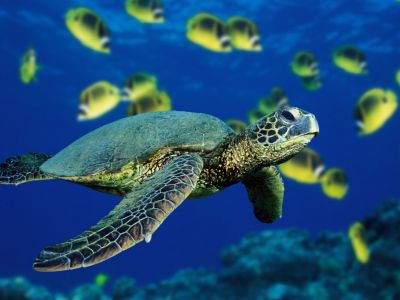Sea turtle declines not all due to human impacts
Humans are pushing sea turtles to the brink of extinction by entangling them in fishing gear, tossing plastic garbage into their habitats, and building resorts on prime nesting beaches, among other affronts. That's the going hypothesis, anyway.
 |
|
Sea turtle [File photo] |
But a new study suggests that our transgressions are peanuts compared to natural oceanic cycles, at least for loggerheads. The findings don't let people off the hook, the authors say, but they do provide new insight into the ways climate can shape turtle populations.
Loggerheads lay their eggs on subtropical beaches around the world. After hatching, baby sea turtles head out to sea where they spend years maturing. When females reach breeding age—25 to 35 years old for loggerheads—they clamber ashore to lay eggs on the beach. Nest counts are the main source of demographic data for sea turtles, but it's hard to estimate population size from these counts.
Between the mid-1990s and 2006, loggerhead nests in Florida—one of the species' nesting epicenters—declined from roughly 55,000 per year to around 30,000. That drop and declines elsewhere prompted U.S. federal agencies to propose upgrading most loggerheads from threatened to endangered under the Endangered Species Act. Numerous studies have shown that fishing bycatch kills an alarming number of sea turtles each year, and the threats posed by many other human activities are well documented. But ecologists Kyle Van Houtan of the National Oceanic and Atmospheric Administration's Pacific Islands Fisheries Science Center in Honolulu and John Halley of the University of Ioannina in Greece wondered if other factors were also at work.
In the new study, published online this week in PLoS ONE, the duo measured the effect of certain ocean conditions on loggerhead nesting, using nest count data from Japan and Florida stretching back as far as the 1950s. Specifically, they looked at two long-term warming and cooling cycles whose effect on sea turtles hadn't been investigated, one in the Pacific where Japanese turtles spend their formative years, and another in the Atlantic, where young Floridian turtles live.
They also looked at recent ocean conditions, in particular the temperature of the sea surface near Japan and Florida the winter before a given breeding season. Such conditions have been shown to influence whether females are robust enough to make the long migration to shore and produce hundreds of eggs.
Using mathematical models, Van Houtan and Halley found a strong correlation between the nest counts in a given year and the state of the long-term oceanic cycles some 3 decades earlier. That's when most nesting females would have been in their first year of life, the researchers say.
Van Houtan and Halley think the two oceanic cycles—the Pacific Decadal Oscillation (PDO) and the Atlantic Multidecadal Oscillation (AMO)—can make or break a young turtle's survival; favorable cycles bring food and good weather, for example. The number of survivors seems to strongly affect the number of nests.
 0
0 






